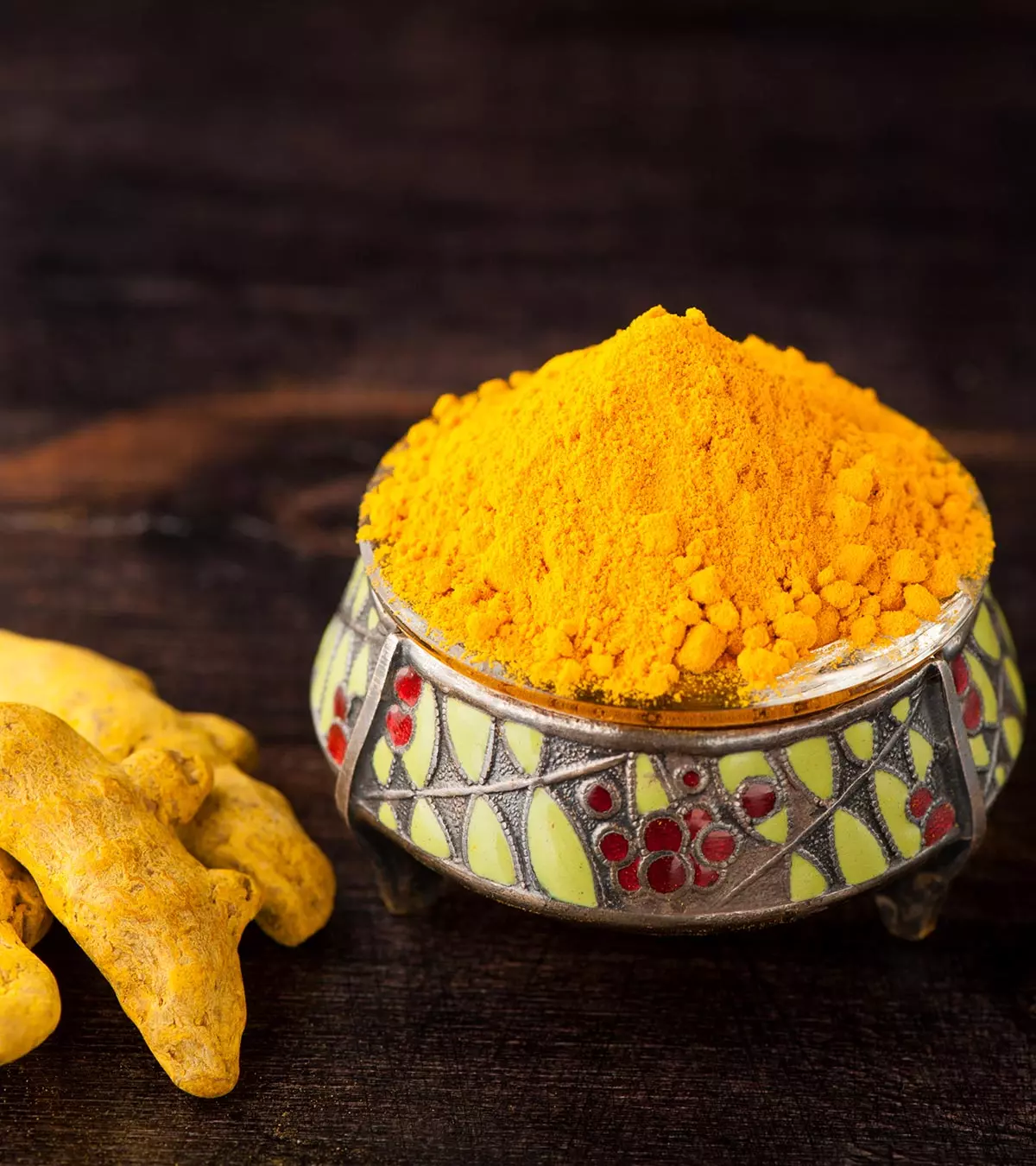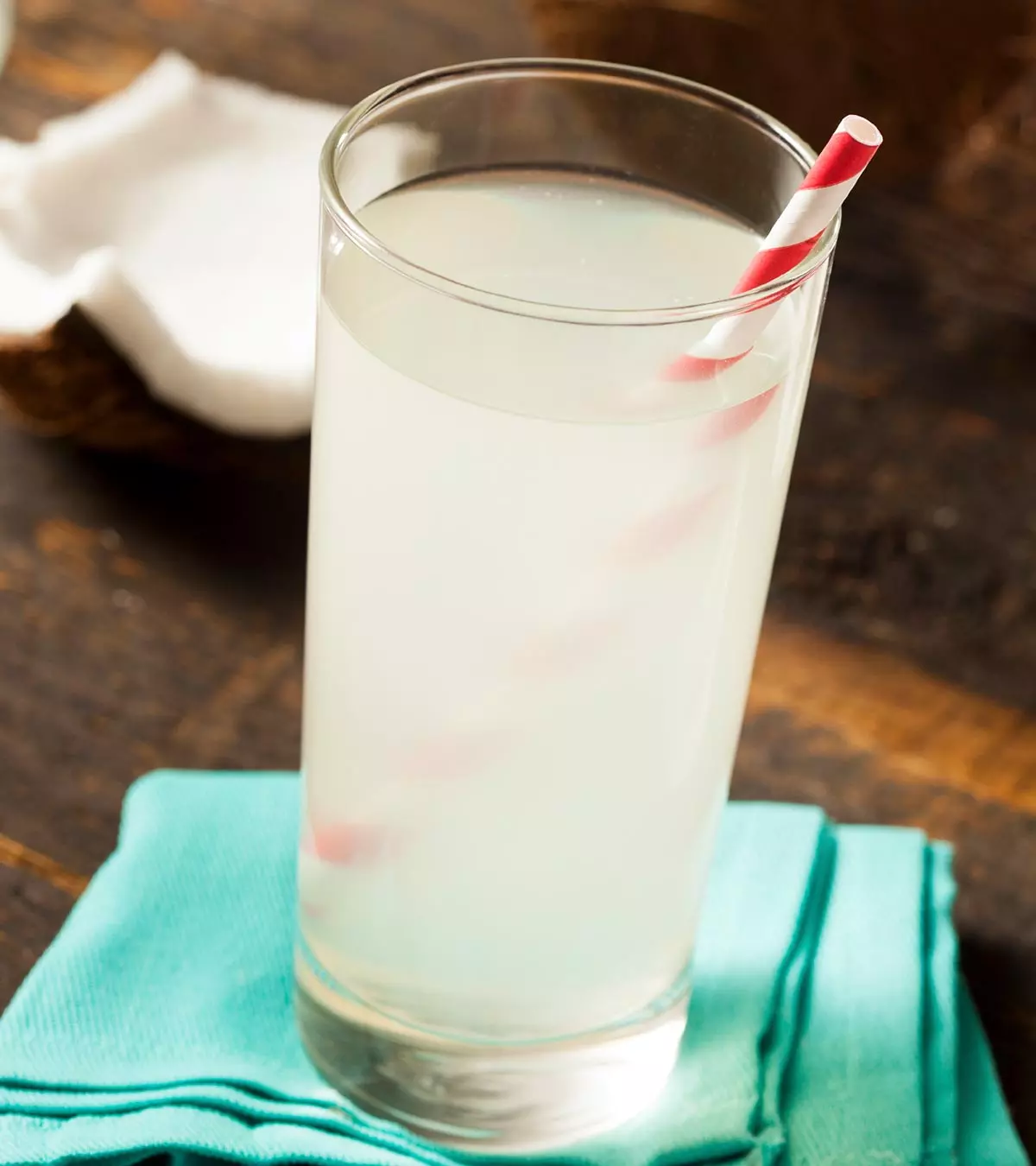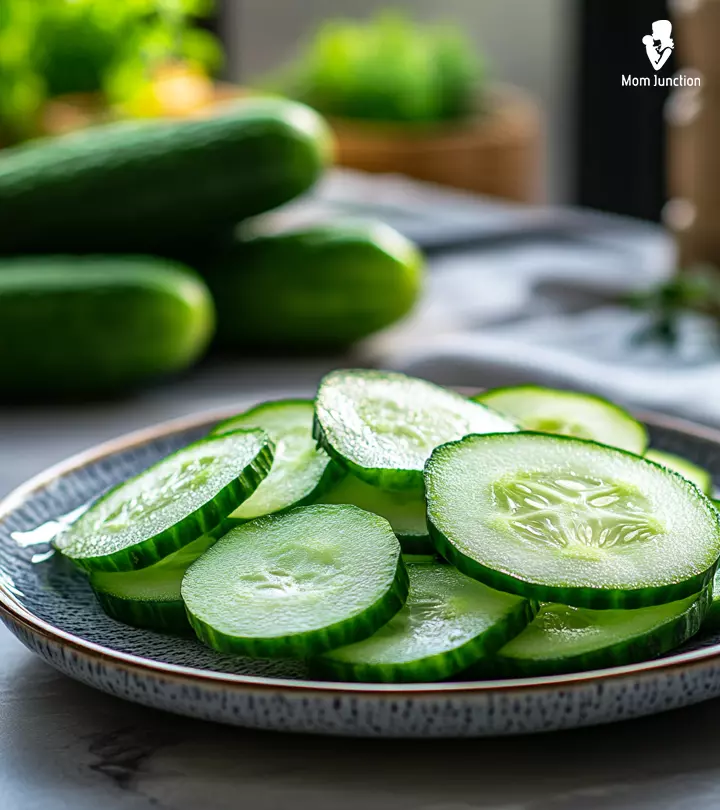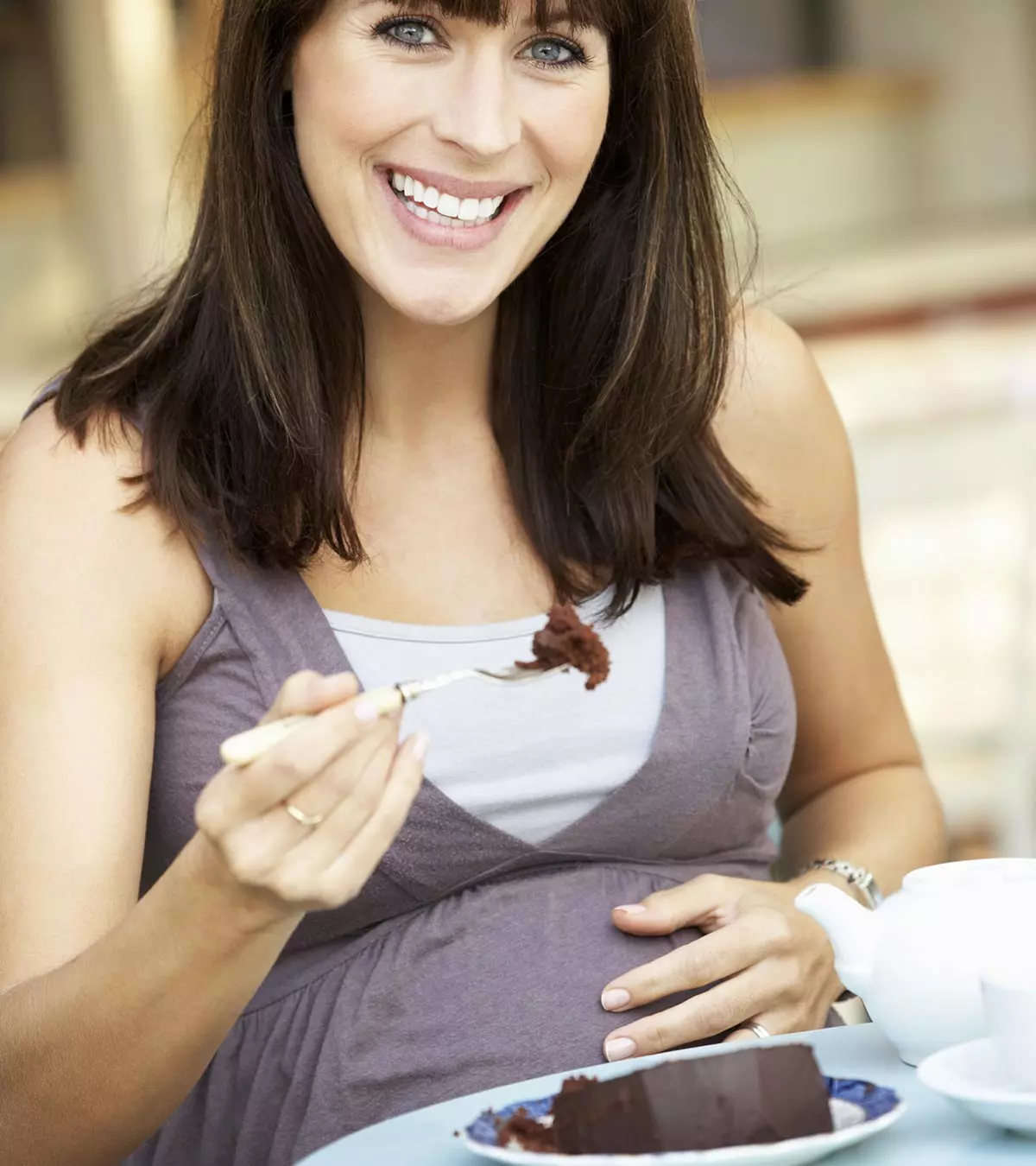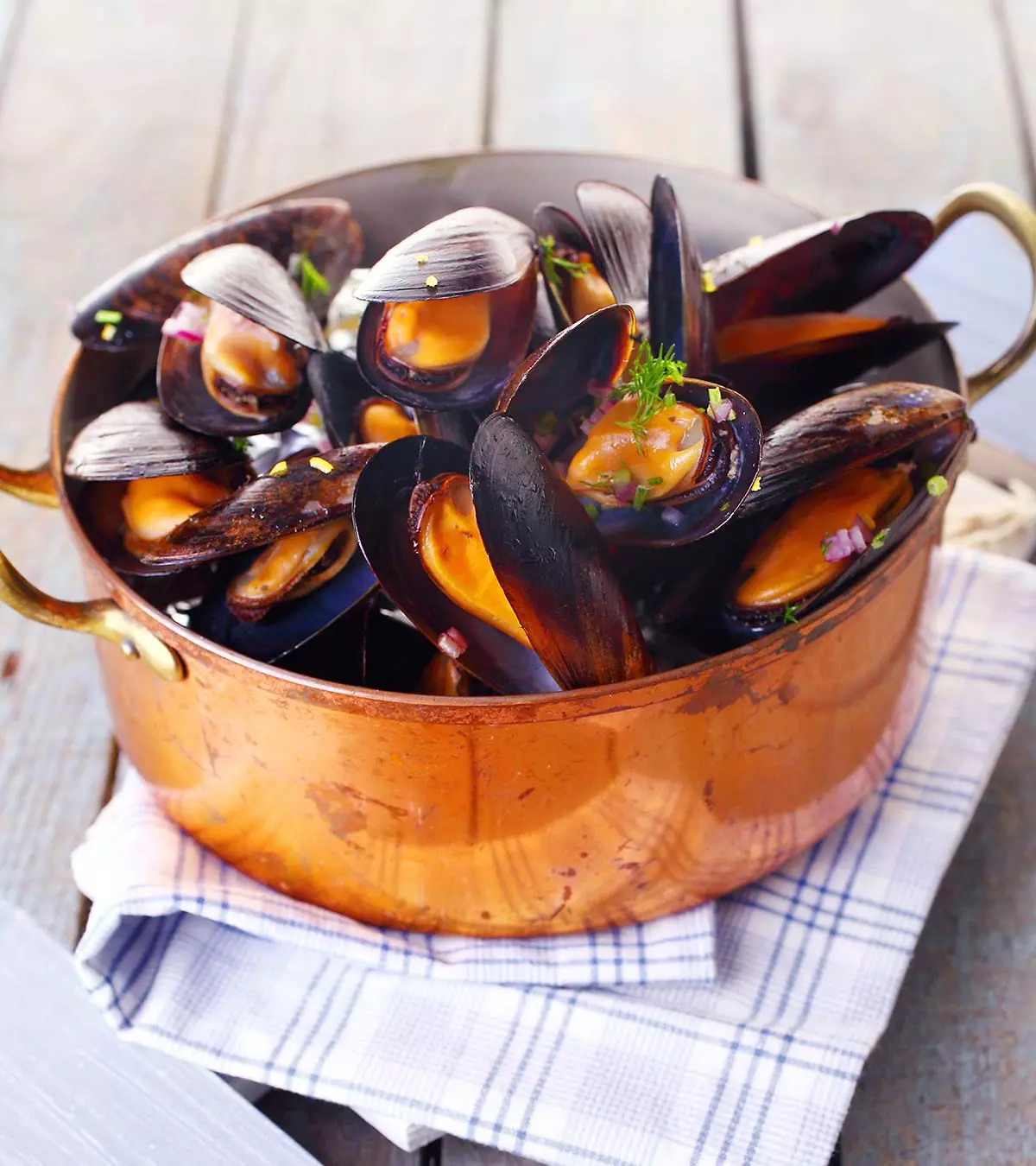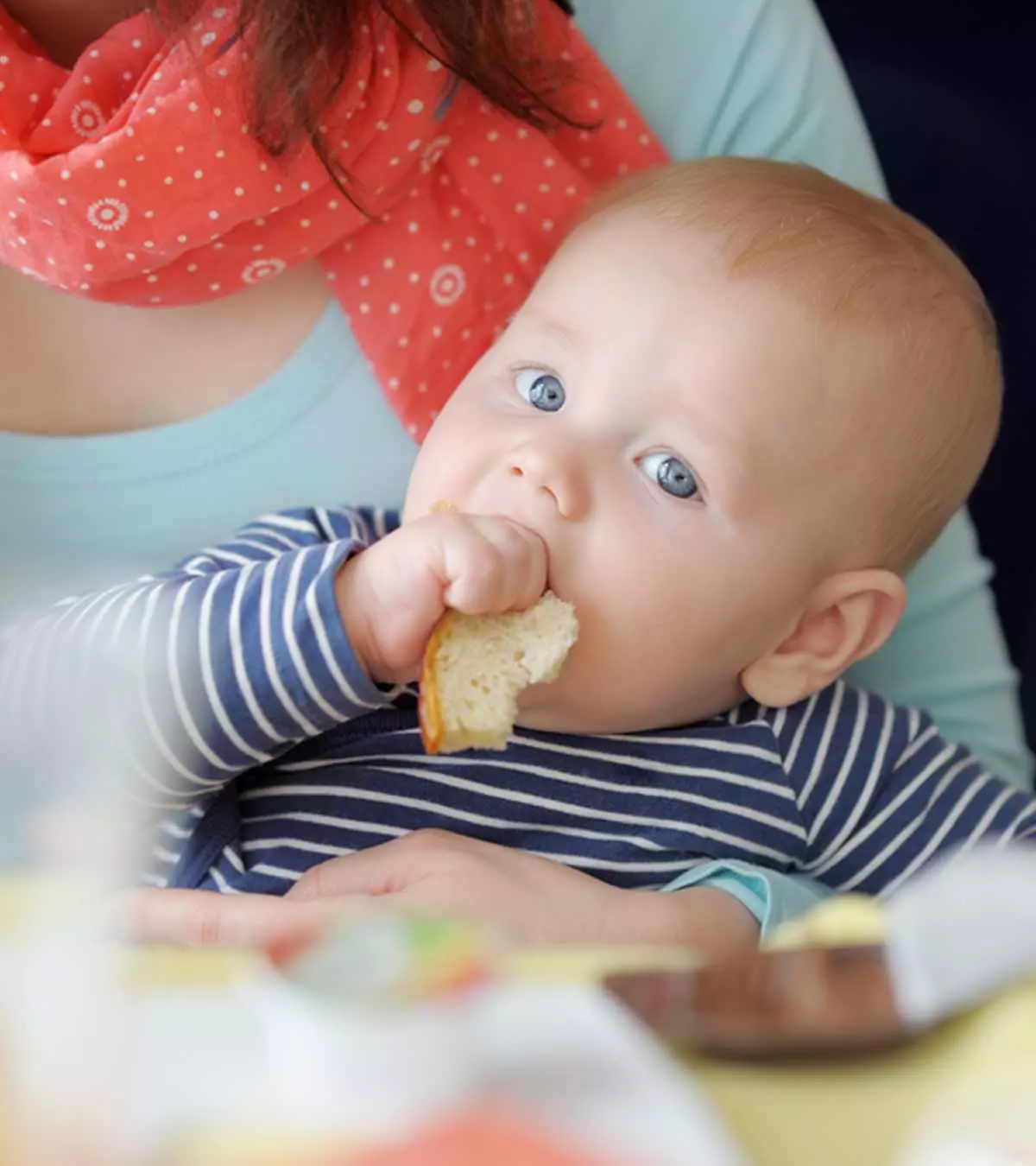
Image: Shutterstock
Parents, especially new ones, often appear to struggle with determining what to feed their infants. Bread for babies can be considered as the first food as it contains a variety of nutrients such as carbohydrates, dietary fiber, and micronutrients. It is made from wheat flour and is a common food for many people worldwide. However, because wheat is a common allergen, take measures while feeding wheat bread to babies for the first time (1).
This post discusses the nutritional content of bread, when you should start feeding your baby wheat bread, and what precautions you should take when feeding it to babies.
Key Pointers
- Whole wheat bread provides multiple nutrients to the babies.
- As per the UK National Health Service, you can introduce bread to six-month-old babies.
- Knowing the right ways to include bread in their routine is the key.
Is It Safe To Give Bread To Babies?
Yes, bread is safe for babies. Experts recommend feeding 100% whole-wheat bread as it can provide considerable amounts of carbohydrates, protein, dietary fiber, and essential micronutrients, like iron, zinc, and thiamin (2). Moreover, bread can help introduce babies to different food textures and flavors. However, while adding it to your baby’s weaning diet, check for possible sensitivity or allergic reactions, especially if you or anyone in your family has a history of allergies.
Babies with a confirmed wheat allergy should avoid all wheat products, including baby cereals, bread, pasta, and crackers. Most infants outgrow wheat allergy within early childhood (3) (4).
Look for breads that do not contain any additives and preservatives such as BHA, BHT, wheat gluten. In the supermarket, one may encounter many bread types, such as whole grain bread, soft, or cornbread, etc. Go through the nutritional content on the package and choose the bread with ingredients such as whole sprouted grains and seeds with minimal or no added oil. You may also consult your pediatrician on the best type of bread for your baby or try making bread at home with healthier ingredients like whole-wheat and whole grains.
When Can You Give Bread To Babies?
According to the UK National Health Service, you can introduce bread to babies from the age of six months (5). Bread can be among the first foods when a six-month-old begins eating solids. Early introduction of bread to babies can help develop their chewing skills and taste preferences. Pick fresh, 100% whole-wheat bread without any seeds or nuts (6). Serve lightly-toasted bread, cut in small pieces that are easy to swallow for a baby without the risk of choking.
 Experts say
Experts sayNutritive Value Of Bread
Below is the proximate composition comparison of one medium-sized slice of refined bread, whole wheat bread, and enriched bread (7) (8) (9). Whole-wheat bread is made from whole-wheat flour that contains all the nutritious parts of the wheat grain, namely bran, germ, and endosperm, while refined wheat flour only contains the endosperm. Enriched bread is made from enriched flour, which is refined flour fortified with nutrients that were lost during the milling process.
| Name | Whole-wheat bread | Refined bread | Enriched bread |
|---|---|---|---|
| Energy (Kcal) | 81.5 | 72.9 | 69.9 |
| Protein (g) | 3.95 | 2.57 | 2 |
| Carbohydrate, by difference (g) | 13.8 | 13.4 | 13 |
| Fiber, total dietary (g) | 1.93 | 0.628 | 0 |
| Calcium, Ca (mg) | 52.3 | 57.6 | 25 |
| Magnesium, Mg (mg) | 24.6 | 7.34 | 0 |
| Phosphorus, P (mg) | 68.1 | 30.8 | 0 |
| Potassium, K (mg) | 80.2 | 31.9 | 20 |
| Sodium, Na (mg) | 144 | 130 | 120 |
| Thiamin (mg) | 0.126 | 0.138 | 0 |
| Riboflavin (mg) | 0.053 | 0.066 | 0.1 |
| Niacin (mg) | 1.42 | 1.3 | 1.1 |
Source:U.S. Department of Agriculture
How Much Bread Should You Give To Your Infant?
Whole-wheat bread in moderation can be an important part of a well-balanced diet. Below is the daily suggested intake for grains, including bread, for babies (10) (11).
| Age (months) | Suggested daily serving |
| 6 to 8 | 1 to 2 ounces (28-56 grams) of iron-fortified infant cereals, bread, and small pieces of crackers and half slice of whole-wheat bread per day |
| 8 to 12 | 2 to 4 ounces (56-113 grams) of iron-fortified cereals, other grains, bread, crackers, noodles, tortilla pieces, etc and one large, one medium, and one small slice of whole-wheat bread per day |
Source: NCBI and South Dakota WIC Program
Precautions To Take While Giving Bread To Babies
Here are some simple precautions you should take to ensure the safe intake of bread for babies and toddlers.
- Prefer whole-wheat bread to refined or enriched bread. Look for “100% Whole-Wheat” labels on the bread packaging.
- Not every “brown bread” is 100% whole-wheat bread. Check the ingredients for the mention of 100% whole-wheat flour. Also, check for the percentage of whole-wheat. Use bread made from 100% whole-wheat flour.
- Avoid multi-grain whole-wheat bread since it may contain seeds and nuts. Only pick single grain (whole-wheat) bread to avoid possible allergic reactions.
- Go for low sodium and no-added sweetener varieties. Also, check for the presence of any other additives, such as food color.
- Check the manufacturing date and “best before” or “use by” date. Prefer fresh bread.
- Consider giving them soft and easily chewable bread that is pureed, soaked in milk or water, or cut into small pieces to prevent the risk of choking.
- Follow a “three to five-day wait” while introducing bread to rule out sensitivities or allergies towards wheat. Add no new food while you are feeding bread to your baby.
- General symptoms of wheat allergy are hives, wheezing, stomach ache, and diarrhea, occurring immediately after the baby eats food made with wheat (1) (3). Babies that experience bloating, vomiting, diarrhea, and stomach ache but no wheezing or hives are likely to have wheat sensitivity or celiac disease (12) (13). It can be hard to distinguish symptoms of wheat allergy or sensitivity from those of celiac disease (14). Therefore, stop feeding wheat products to the baby and consult a doctor for the precise diagnosis. A study by multiple institutes discovered that around 21.3 cases per 100,000 person-years were diagnosed with celiac disease each year among children.
- Babies with wheat allergy or wheat sensitivity can have bread made from flours of almonds, legumes, and tubers. Take your pediatrician’s opinion before introducing these alternative options. Ancient grains such as millet, quinoa, buckwheat, and teff make nutritious breads.
 Point to consider
Point to consider- If wheat suits the baby, then feed whole-wheat bread in moderation and as part of a well-balanced diet. Overconsumption may fill up the baby’s tummy and leave no space for breast milk and other foods.
- Toast the bread and cut it into small pieces that are easy to swallow. If the baby does not like the bread, wait for a few days and try again. You can also introduce bread in combination with other foods, such as vegetable and fruit purees.
- Babies above eight months of age can consume small, bite-sized lightly toasted bread, breadsticks, bread crusts, and pitta bread as finger foods (15).
- For toddlers who eat a wide variety of solids, you can consider trying other types of bread, such as whole-grain cornbread, whole-grain or sprouted rye bread, whole-grain multi-grain bread, sourdough bread, and flax bread, after consulting a pediatrician.
How To Make Bread At Home
Simple ingredients and techniques can help you make chemical and preservative-free bread at home for your little one. We bring you an easy whole wheat bread recipe, which can help you make soft and fluffy bread at home.
You Will Need:
- 3 cups whole wheat flour
- 3 cups all-purpose flour
- 1tbsp salt
- 1tsp sugar
- 1tbsp olive oil
- 2tsp levelled dried yeast
- 1 1/2 cups water
How To:
- Take some warm water, add sugar, and stir it until it dissolves, and then add the yeast to it. Keep this mixture aside until it froths.
- Take a large bowl and add the flour to it along with the salt. Make a well in between and add the olive oil.
- Add the yeast mixture to the above bowl and make a firm dough. Use some warm water if required while kneading the dough.
- On a clean surface, sprinkle some flour and knead the dough for 10 more minutes.
- Grease a large bowl, add the dough to it, and cover it with a cloth. Keep this in a warm place for an hour.
- Take the raised dough on the floured surface and knead it for a minute more.
- Grease 2 1lb loaf tins, divide the dough, stretch it, make it fit in the tin, cover it with cling wrap and keep aside for 45 mins.
- Preheat the oven to 375 deg F. Remove the plastic from the above tin and place the tin in the oven. Bake for 20-30 minutes. Let the bread cool, and then slice it.
Tasty Bread Recipes For Babies
You can feed bread to your baby as a simple toast or by soaking it in a small quantity of warm milk. In addition, you may incorporate bread in different forms such as bread crust and bread crumbs on pureed desserts or meals to give your little one extra nutrition and crunch. Alternatively, you may use the following recipes.
1. Jammy bread fingers

Image: Shutterstock
The easy-to-prepare finger food recipe can be a part of your baby’s breakfast meal.
You will need:
- 1 whole-wheat bread slice
- 1tsp blueberry jam (or any jam of choice)
How to:
- Slice the whole-wheat bread into thin fingers.
- Apply jam to these slices of bread and serve immediately.
- You can slightly toast the bread before slicing.
The sweet and tangy flavor of the jam mixed with the nutritious bread is surely one quick and delicious homemade baby food that you can include in your baby’s diet as per their age and preferences.
2. Buttery banana bread slices
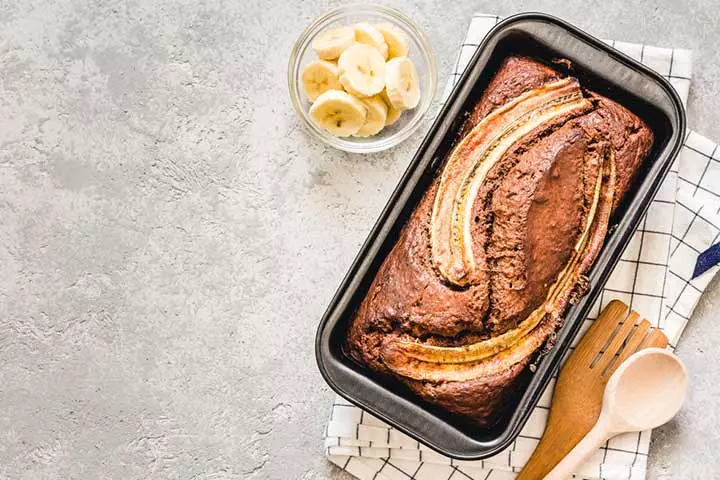
A perfect finger food recipe made with nutritious ingredients, like fresh fruits and peanut butter. This is suitable for toddlers.
You will need:
- 1 banana bread slice
- 1tsp plain peanut butter (without peanut chunks)
- 1tbsp tiny mixed fruit pieces (mango and strawberry)
How to:
- Spread the peanut butter on the banana bread slice and decorate with tiny mixed fruit pieces.
- Serve immediately with a cup of warm milk or fresh homemade veggie juice.
- You can add toasted sesame seeds and flaxseeds to this recipe.
3. Multi-grain French toast
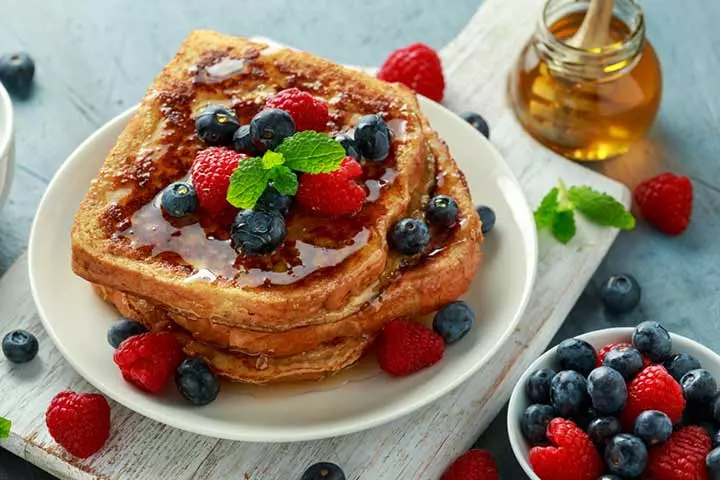
French toast is a delicious traditional treat for babies above 12 months of age.
You will need:
- Multi-grain bread slice
- ¼tsp cinnamon powder
- 1tsp brown sugar
- 2tbsp butter
- 1 egg
- ⅛ cup whole milk
- 1tsp maple syrup
How to:
- Add cinnamon, sugar, egg, and milk in a small bowl, whisk well and set aside.
- Keep a skillet over medium heat and put butter onto it to melt.
- Dip the bread in the egg mixture and then place it on the skillet to fry.
- Fry the slice until it turns golden brown from both the sides.
- Drizzle some maple syrup and serve the French toast while still warm.
 Quick tip
Quick tip4. Cheesy mini sandwiches

Mini sandwiches are a healthy snack option for babies and toddlers.
You will need:
- 2 whole-wheat bread slices
- 1tsp mint sauce
- 1tsp tomato sauce
- ¼ cup cucumber (grated)
- 1tbsp cream cheese
How to:
- Take a small mixing bowl and mix mint sauce, tomato sauce, and cream cheese in it.
- Spread a thick layer of the mixture to one slice, top with grated cucumber, and cover with another slice.
- Press the sandwich gently and cut it into four small squares.
- Serve immediately with fresh vegetable juice or a cup of warm milk.
- You can also add cooked cottage cheese to this recipe to intensify its nutritional value.
5. Bread upma
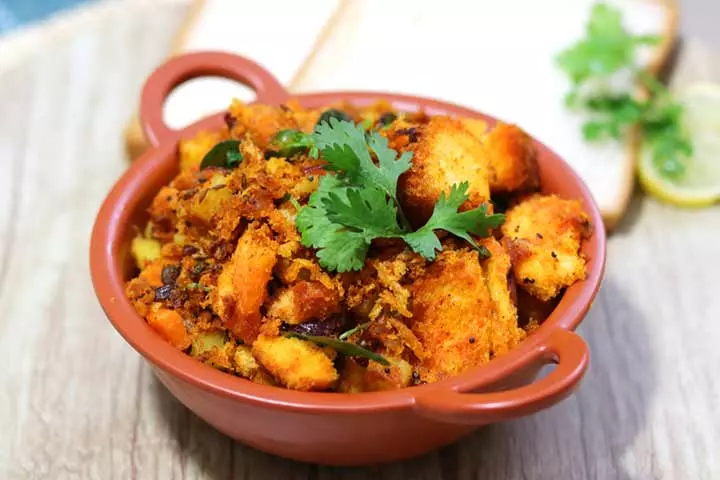
A healthy and delicious recipe suitable for babies above ten months of age.
You will need:
- 1 cup crumbled whole-wheat bread
- 2tbsp peanuts
- 1tsp lemon juice
- 1 small onion (chopped)
- 1 small tomato (diced)
- 1tsp mustard seeds
- 1/4tsp turmeric powder
- 1/4tsp salt
- 1tbsp oil
- 4-5 curry leaves
How to:
- Put oil in a thick bottom pan, add peanuts, and fry them for ten seconds.
- Add mustard seeds, curry leaves, and onion and fry until onions turn golden brown.
- Now, add tomato, turmeric, and salt, and cook for five minutes.
- Add crumbled bread to the mix and give a nice toss. Cook for five minutes with the lid closed.
- Transfer the cooked bread upma to a serving plate, add lemon juice, and serve.
After the introduction of solids, it may be necessary to wait a few more weeks before incorporating bread into your baby’s diet. It is advisable to consult with your pediatrician to determine the appropriate size and portion of bread suitable for your little one.
Alternatives Of Bread For Babies
Some food items that can be alternatives to bread for babies are:
- Whole-wheat pancakes
- Oats pancakes
- Millet pancakes
- Whole-wheat chapatis
- Corn tortillas
Frequently Asked Questions
1. Can I feed white bread to my baby?
White bread is softer in texture than whole wheat or millet bread. Thus, several parents prefer to feed white bread to babies. However, it is essential to note that the content of fiber, protein, and several other nutrients, such as magnesium, phosphorus, and potassium is relatively less in white bread (7) (8) (9). Hence, it is good to pick bread made of whole wheat for babies. However, you can also feed them enriched white bread occasionally.
2. When can my baby eat bread and butter?
Babies can eat bread and butter from six months of age. You can use unsalted butter and apply it on lightly toasted bread slices that babies can eat as finger foods and practice self-feeding. Alternatively, you can add small amounts of butter to purees, mashed foods, and porridge to enhance the food’s flavor (16). However, keep the use of butter minimal as excessive butter intake isn’t good for long-term health.
3. Are there any potential risks associated with giving bread to babies?
Consumption of wheat bread may cause an allergic reaction if the children are sensitive to wheat. Giving bread to babies younger than six months of age is not recommended, as their digestive systems are not yet mature enough to handle solid foods. For older babies, there is a risk of choking if bread is not cut into small pieces.
4. How does the preparation method, such as toasting or microwaving, affect the safety and nutrition of bread for babies?
The preparation method followed has been shown to alter the glucose response of the bread (18). Toasting or microwaving bread does not significantly affect its safety or nutrition for babies, as long as the bread is not overcooked or burned. Overcooking at high temperatures leads to the formation of acrylamide, which at higher levels may cause cancer (19) Microwaving bread for longer periods may make the bread hard and chewy. However, it is important to note that microwaving bread can cause it to become hot and may increase the risk of burns.
5. Can babies with special dietary needs, such as those following a gluten-free diet, consume bread safely?
Babies with celiac disease or gluten intolerance should not consume bread that contains gluten. However, there are many gluten-free bread options, such as cornbread, rye bread, and soy flour bread, available that can be safe for babies with special dietary needs (20).
6. Is it better to give babies store-bought bread or homemade bread?
Homemade bread can be a healthier option for babies, as it allows parents to control the ingredients and ensure that there are no additives or preservatives that may be harmful to babies (21). But many parents prefer buying store-bought bread as it’s convenient. Read the label carefully and make an informed choice while selecting bread for the baby.
7. What type of bread is easiest for babies to digest?
Whole wheat bread can be easier for babies to digest than white bread, as it contains more fiber and nutrients. However, it is important to introduce bread gradually and monitor for any signs of digestive discomfort or allergies. A study found that fermented sourdough bread is easily digestible when compared to bread made using baker’s yeast (22)
Bread for babies can be a great first food because of its nutrient-rich components. It is prepared from wheat flour and contains carbohydrates, dietary fiber, and minerals. While several types of bread are available, 100% whole-wheat bread and bread made with diverse grains, legumes, and seeds are preferred. However, since wheat is a common allergen in babies, follow a “wait rule” when introducing bread to babies to watch out for any adverse reactions. You should also search for bread that is free of additives and preservatives.
Infographic: Nutritious Bread Recipes For Baby-led Weaning
Baby-led weaning enables the baby to self-feed using their fingers. Since holding the food with fingers can be tricky for babies, we bring you delectable yet healthy baby-led weaning bread recipes that a baby can hold and eat comfortably. Go through these recipes and turn the plain bread into a nutritious delight that your baby will love to relish. Pin these recipes and share them with fellow parents.
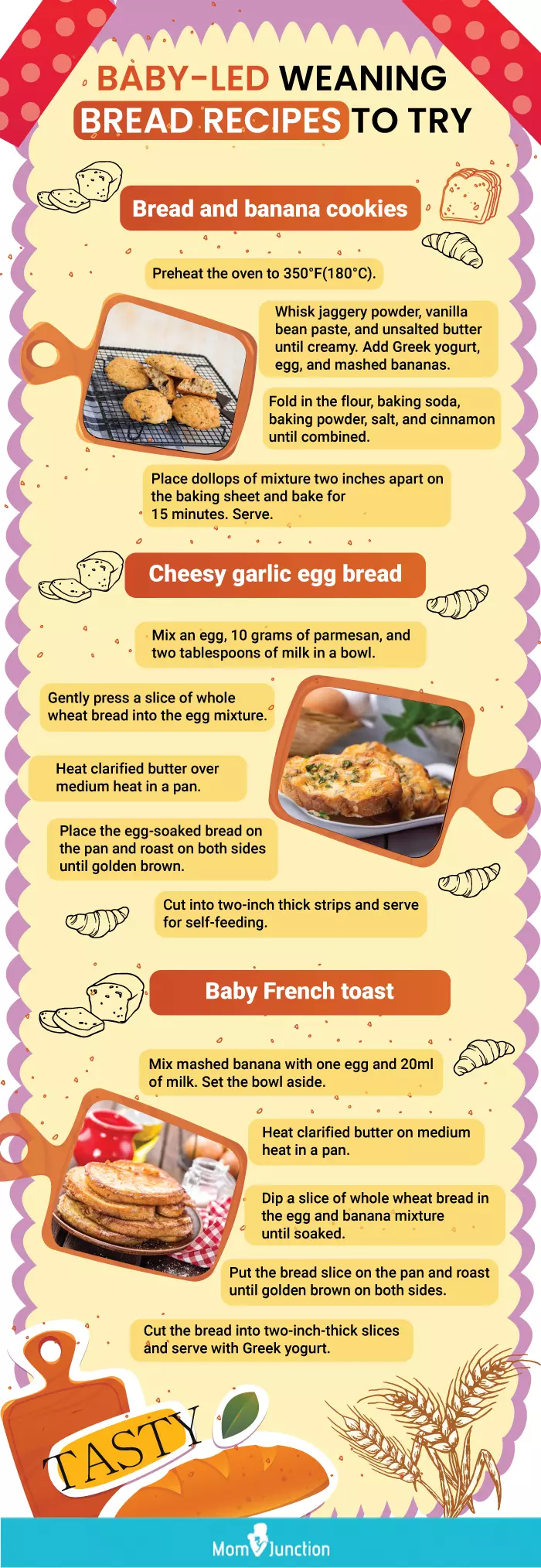
Illustration: Momjunction Design Team
Illustration: When Can Babies Eat Bread? Safety Precautions And Recipes

Image: Stable Diffusion/MomJunction Design Team
Learn how to feed your baby safely with this helpful video focusing on bread! Learn about the best bread varieties and methods for preparing it for your child’s needs.
References
1. Food Allergies; FDA.
2. Whole Grains Fact Sheet; International Food Information Council Foundation
3. Wheat Allergy; American College of Allergy, Asthma & Immunology
4. Cereals and Grains; University of Nebraska Lincoln
5. Your baby’s first solid foods; NHS
6. Choking Hazards; CDC
7. Bread, whole-wheat, commercially prepared, FDC ID: 335240 ; Fooddata Central, USDA
8. Bread, white, commercially prepared; FDC ID: 325871; Fooddata Central, USDA
9. Enriched bread; Fooddata Central, USDA
10. Michelle Klerks, et al.Infant Cereals: Current Status, Challenges, and Future Opportunities for Whole Grains, Nutrients (2019).
11. Feeding Guide: 6-12 Months; South Dakota Department of Health
12. Should you cut out bread to stop bloating?; NHS13. Symptoms of Celiac Disease; Celiac Disease Foundation
14. Myth vs. fact: Celiac disease vs. wheat allergy; Food Allergy Canada
15. Weaning your baby; Government of UK
16. FOOD FOR 6 TO 24 MONTHS OLD CHILDREN; UNICEF
17. When should I introduce wheat into my baby’s diet? Healthychildren.org; AAP
18. P Burton and H J Lightowler;The impact of freezing and toasting on the glycaemic response of white bread; Eur J Clin Nutr (2008)
19. Acrylamide and Diet, Food Storage, and Food Preparation; FDA
20. Wheat Allergy Diet for Children Stanford Medicine
21. Homemade vs store-bought baby food Children’s National Hospital
22. Carlo Giuseppe Rizzello et al.;Sourdough Fermented Breads are More Digestible than Those Started with Baker’s Yeast Alone: An In Vivo Challenge Dissecting Distinct Gastrointestinal Responses; Nutrients 2019
Community Experiences
Join the conversation and become a part of our nurturing community! Share your stories, experiences, and insights to connect with fellow parents.
Read full bio of Deepa Deshmukh
Read full bio of Swati Patwal
Read full bio of Rohit Garoo
Read full bio of Ghazia Shah








